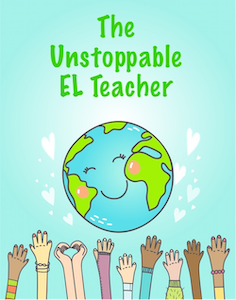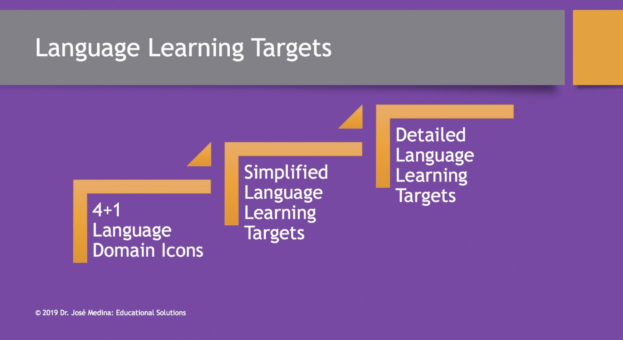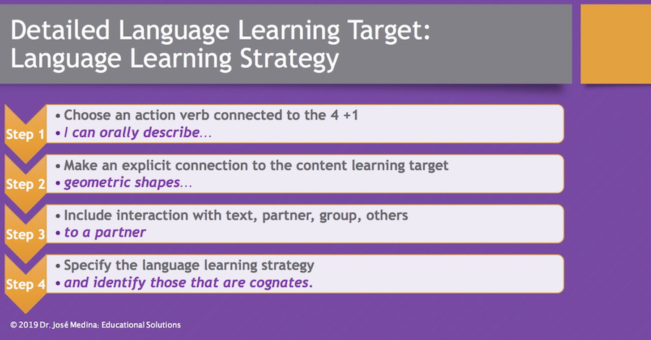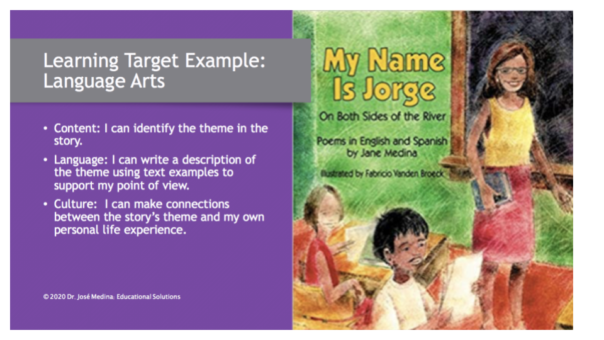How to Write Language and Culture Objectives
A MiddleWeb Blog
 Many teachers are familiar with content objectives. Some may also be familiar with language objectives. But if you’re like me, you might not have heard of a culture objective.
Many teachers are familiar with content objectives. Some may also be familiar with language objectives. But if you’re like me, you might not have heard of a culture objective.
A culture objective develops students’ socio-cultural competence and connects the content to their backgrounds and personal experiences. These kinds of objectives also help us make sure we positively reflect students’ cultures in our lesson plans.
In my podcast conversation (Ep.17) with Dr. José Medina, an educational consultant specializing in biliteracy instructional best practices, we walked through his process of writing both language and culture objectives. Here’s what I learned!
What is a language objective?
A language objective identifies
- how students must use the language to comprehend the content and/or
- the language required to express understanding of the content.
Without a language objective, students are unclear about what they are supposed to do with the content or how to access it.
When teachers have identified a language objective, they make these expectations clear for students. Additionally, teachers now have a better idea of how to support students when a language objective is written.
A language objective is the how of a lesson while the content objective is the what of the lesson. Students need both to be successful at school. Teachers should also support these objectives with engaging lesson delivery.
4 + 1 Language Domains
One component in writing a language learning target is what Medina calls “4 + 1”. The four refers to the different language domains:
1) speaking
2) listening
3) reading
4) writing
Though an ideal lesson would require the use of all of the domains, Medina asks teachers to identify the main domain that they are focusing on.
The “+1” refers to the language learning strategy, such as noticing the order of adjectives in a sentence.
Ideally, teachers would post the five icons (the four language domains and the language learning strategy) displayed on the board. Only one of the icons would be identified, possibly by a clip, to visually communicate the domain that students will be developing in that particular lesson.
Simplified & Detailed Language Learning Targets
There are four steps to this process of creating a language learning target, which is Medina’s term for a language objective. If you follow these steps, you will be able to form a single sentence as a language objective.
1. Choose an academic verb for a language domain
Think about the thinking that students have to do when engaging with the content. Some of the most frequent categories of academic verbs used in schools are recall, explain, argue, discuss. Medina’s approach calls for us to identify one of the four language domains to be connected to this academic verb.
2. Identify the content
At this point, teachers select the content of the lesson. These are the discipline-specific topics, concepts, or knowledge found in the standards and curriculum guide.
3. Include a form of interaction
Think about how students will be interacting with the content. Will it be through an article, a video, an experiment, or a software program? With a partner, in groups, or including the entire class? If you have these first three steps, Medina calls this a simplified language learning target.
4. Specify the language learning strategy
The fourth step is optional, but adding it in results in what Medina calls a detailed language learning target. This step requires us to identify the strategy students will use to learn a language.
We are asking students to be metacognitive about language acquisition in this step. With this addition to a language objective, students are more likely to reach into their home language toolkit to find similarities and differences between the target language at school and their heritage language.
Additionally, having this step empowers them to be more in charge of their language learning journey. They develop linguistic tricks that turbocharge their ability to learn a new language.
Culture Objectives
A culture objective develops students’ sociocultural competence. The goal of a culture objective is to connect students’ lived experiences and backgrounds to the content, positively reflect students’ cultures within the curriculum, and expand their linguistic repertoire.
Medina suggests four ways teachers can write a culture learning target:
1. Amplify the voices of marginalized communities
Include experiences of individuals and communities that are marginalized by society. Positively present how they have contributed to the field. Additionally, celebrate how their stories, symbols, history and practices connect to the content.
Make sure to highlight what individuals from marginalized communities can teach us about the content. Adding this aspect creates space for students from minority backgrounds to be reflected in a positive light within the curriculum.
An easy way to do this is through picture books where the main character is from a marginalized community and is being shown in a positive narrative.
2. Connect to the child and/or the real world
Form a connection between the content and something in the child’s lived experiences and/or an actual example outside of school. This might be as simple as asking students to think about how a content-specific topic shows up in their lives, families, communities, or cultures.
You can also partner with institutions, organizations, non-profits, or advocacy groups to find authentic examples of how the content appears in the world outside of school.
3. Encourage cross-linguistic connections and translanguaging
When we teach content, we can invite students to read articles and watch videos about the same content to raise students’ comprehension.
When we teach a language pattern or feature of language, we pause to ask them if they have the same things in their home languages. This opportunity deepens their understanding of both languages and develops their metalinguistic skills, which strengthens their language-learning skills.
Lastly, we encourage students to have conversations in their home language about the content and allow them to translanguage. A translanguaged sentence might consist of words and phrases from different languages. Alternatively, a translanguaged conversation might start with English, move to Hindi in the middle, and end with English again.
The key is to allow students to mobilize from their entire linguistic repertoire, rather than be limited by just one language.
4. Present social and academic language as equals
For Medina, context is key to language. He encourages teachers to not overvalue academic language and undervalue social language for they are both valuable. What we are encouraged to do as educators is to teach students the appropriate contexts for each.
When we show students that both social and academic language are appropriate in their own contexts, we expand students’ linguistic repertoire. Their language now consists of social language, academic language, and language patterns used by people from minority backgrounds.
Though this article is about content, language, and culture objectives, at another deeper level it is about advocating for multilingual learners. When you write language objectives, you have the chance to provide an equitable learning experience.
When you craft culture objectives, you can intentionally include people from marginalized communities and communicate to students that people from minority backgrounds hold a central role in our curriculum.
Visit Tan’s podcast page to discover his latest conversations.



































Great writing guide! I will definitely use your advice. I hope that you will continue to make such educational content.
Hi, Olivia.
Thank you for your kind words. Dr. Jose Medina is fantastic and always provides such great ideas! Wishing you the best navigating this year!
I really was inspired by the podcast and article. I look forward to implementing these practices in my classroom – thank you so much!!!
Hi, Anna.
It’s my pleasure! Wishing you the best as you continue to educate students with a social justice lens.